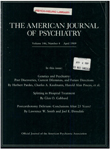Preliminary data on the relationship between nortriptyline plasma level and response in depressed children
Abstract
Twenty-two subjects 6-12 years old who met Research Diagnostic Criteria and DSM-III criteria for major depressive disorder received a fixed daily dose of nortriptyline during an 8-week protocol. Weekly plasma levels were measured; the raters performing behavioral assessments were blind to these levels. There was a highly significant difference between the mean steady-state plasma levels and the milligram-per- kilogram doses of the responders and nonresponders. The data suggest that the lower limit of the therapeutic range of nortriptyline in children (over 60 ng/ml) is similar to that reported for adults. The disadvantages of the use of a milligram-per-kilogram dose rather than a pharmacokinetic approach are discussed.
Access content
To read the fulltext, please use one of the options below to sign in or purchase access.- Personal login
- Institutional Login
- Sign in via OpenAthens
- Register for access
-
Please login/register if you wish to pair your device and check access availability.
Not a subscriber?
PsychiatryOnline subscription options offer access to the DSM-5 library, books, journals, CME, and patient resources. This all-in-one virtual library provides psychiatrists and mental health professionals with key resources for diagnosis, treatment, research, and professional development.
Need more help? PsychiatryOnline Customer Service may be reached by emailing [email protected] or by calling 800-368-5777 (in the U.S.) or 703-907-7322 (outside the U.S.).



